
Top (Line) Dawg Entertainment: Ducks’ Reunited First Line Fueling Success
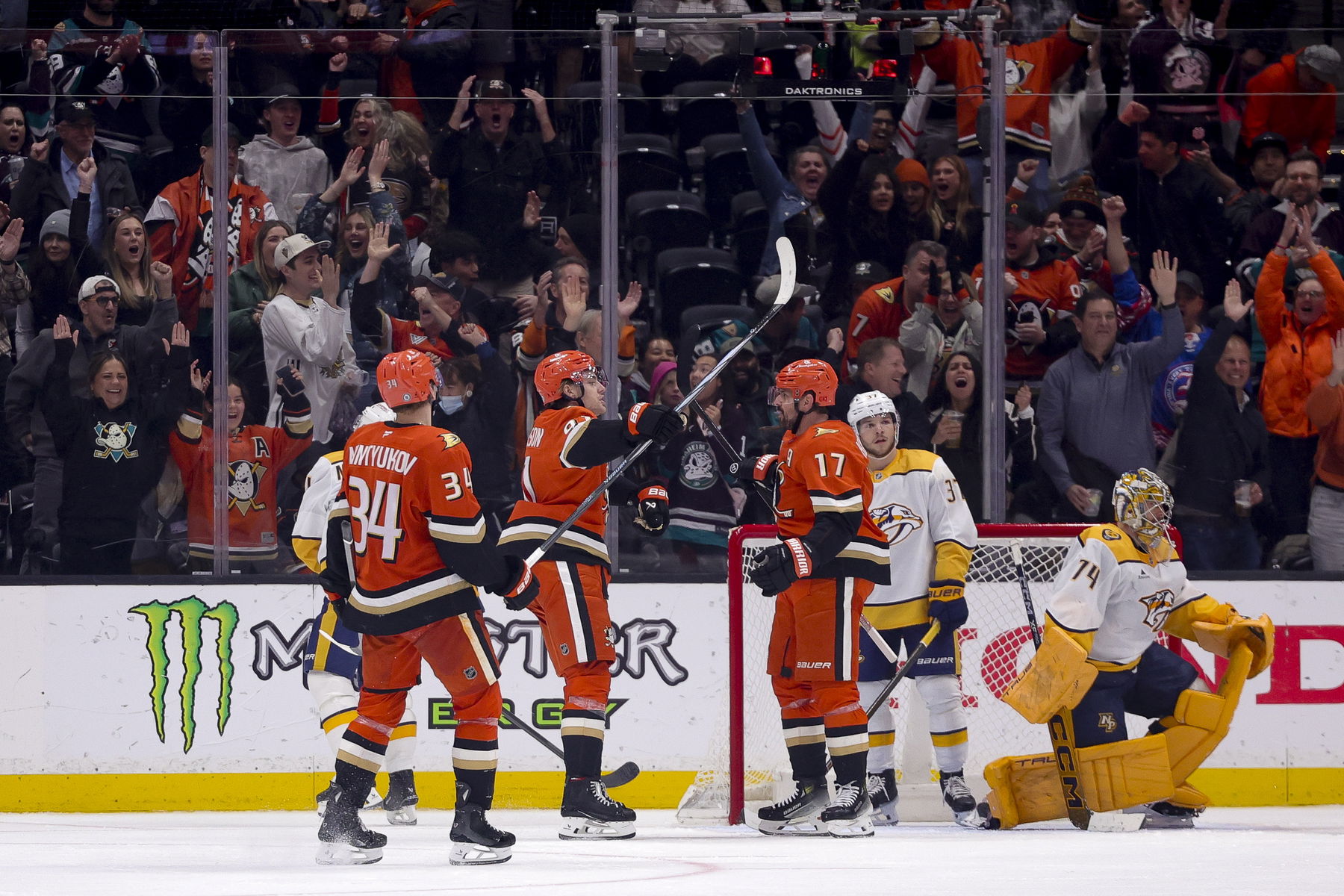 Mar 14, 2025; Anaheim, California, USA; Anaheim Ducks left wing Alex Killorn (17) celebrates with center Leo Carlsson (91) and defenseman Pavel Mintyukov (34) after scoring against the Nashville Predators during the third period at Honda Center. Mandatory Credit: Ryan Sun-Imagn Images
Mar 14, 2025; Anaheim, California, USA; Anaheim Ducks left wing Alex Killorn (17) celebrates with center Leo Carlsson (91) and defenseman Pavel Mintyukov (34) after scoring against the Nashville Predators during the third period at Honda Center. Mandatory Credit: Ryan Sun-Imagn ImagesAfter the Ducks’ thrilling comeback victory in overtime over the New York Rangers, broadcast host Aly Lozoff posed the question to Leo Carlsson, ‘Where is the no-quit attitude coming from?’
“I don’t know,” Carlsson said. “I just think everybody has that dawg in them. It’s easy.” If that's the case, Carlsson is head of the pack right now. He’s been at a point-per-game pace since the beginning of February and his first four-point game as an NHLer on Mar. 30 helped spur the Ducks’ comeback against the Rangers.
His goal on Sunday against the Toronto Maple Leafs made him the first Ducks player in franchise history, aged 20 years or younger, to have a 20-goal season. Another goal scored this season would make him the highest-scoring player, age 20 or younger, passing teammate Mason McTavish.
After having a game management plan which limited him to two games a week and no back-to-backs until December during his rookie season, the first half of Carlsson’s sophomore season did not look great from a point production standpoint. He had just 16 points in 45 games, with 31 games between November and February separating his last two multi-point games. While he was on pace to surpass his rookie season total of 29 points, the lack of production was a bit surprising—and perhaps concerning.
The 4 Nations Face-Off felt like a timely reprieve, allowing Carlsson to be around his fellow countrymen for a couple of weeks and possibly experience playing in a best-on-best tournament. Carlsson played in Sweden’s final game of the tournament against Team USA. While he wasn’t on the scoresheet, the glimpses he’d shown with the Ducks on how much he can impact a game were on display.
![Feb 17, 2025; Boston, MA, USA; [Imagn Images direct customers only] Team Sweden forward Leo Carlsson (91) controls the puck while Team USA defenseman Brock Faber (14) defends during the second period in a 4 Nations Face-Off ice hockey game at TD Garden. Mandatory Credit: Bob DeChiara-Imagn Images](https://deweb-519a7.b-cdn.net/post-images/01f3cfb0-a8f6-4dc7-8242-ebe7ae1f85d3.jpeg) Feb 17, 2025; Boston, MA, USA; [Imagn Images direct customers only] Team Sweden forward Leo Carlsson (91) controls the puck while Team USA defenseman Brock Faber (14) defends during the second period in a 4 Nations Face-Off ice hockey game at TD Garden. Mandatory Credit: Bob DeChiara-Imagn Images
Feb 17, 2025; Boston, MA, USA; [Imagn Images direct customers only] Team Sweden forward Leo Carlsson (91) controls the puck while Team USA defenseman Brock Faber (14) defends during the second period in a 4 Nations Face-Off ice hockey game at TD Garden. Mandatory Credit: Bob DeChiara-Imagn ImagesCarlsson had four points in the Ducks’ first three games after the 4 Nations break. In total, he’s had 21 points in the 20 games since the break. Both Ducks general manager Pat Verbeek and head coach Greg Cronin have noted the uptick in Carlsson’s performance since returning from the tournament, citing an increase in his confidence, pace and willingness to shoot the puck.
“Confidence is a funny thing,” Verbeek said. “ These kids have to realize that they can do it. But, I think the other thing with Leo coming out of (4 Nations) is he's had a more aggressive mindset with his shooting. You’re starting to see him shoot the puck a lot more versus passing the puck. And that leads to another thing, being confident (enough) to wanna shoot the puck to score. He’s got a great shot. It just frustrates me sometimes not seeing him shoot the puck when he can shoot the puck. His mindset has been completely different since he got back and it’s been great.”
“Since the 4 Nations tournament, he’s come back and he seems like he has more pace to his game,” Cronin said. “There’s more explosiveness.
“Pat and his staff did a lot of work scouting him when they drafted him and I remember asking Pat, ‘Is he a playmaker or is he a goalscorer?’ Pat said he could do both. He's got an elite shot and we weren't seeing that a lot earlier (this season). Now, we're starting to see it. I think he's got a release that can be deceiving. I think he catches goalies off guard. I think he's got a really bright future.”
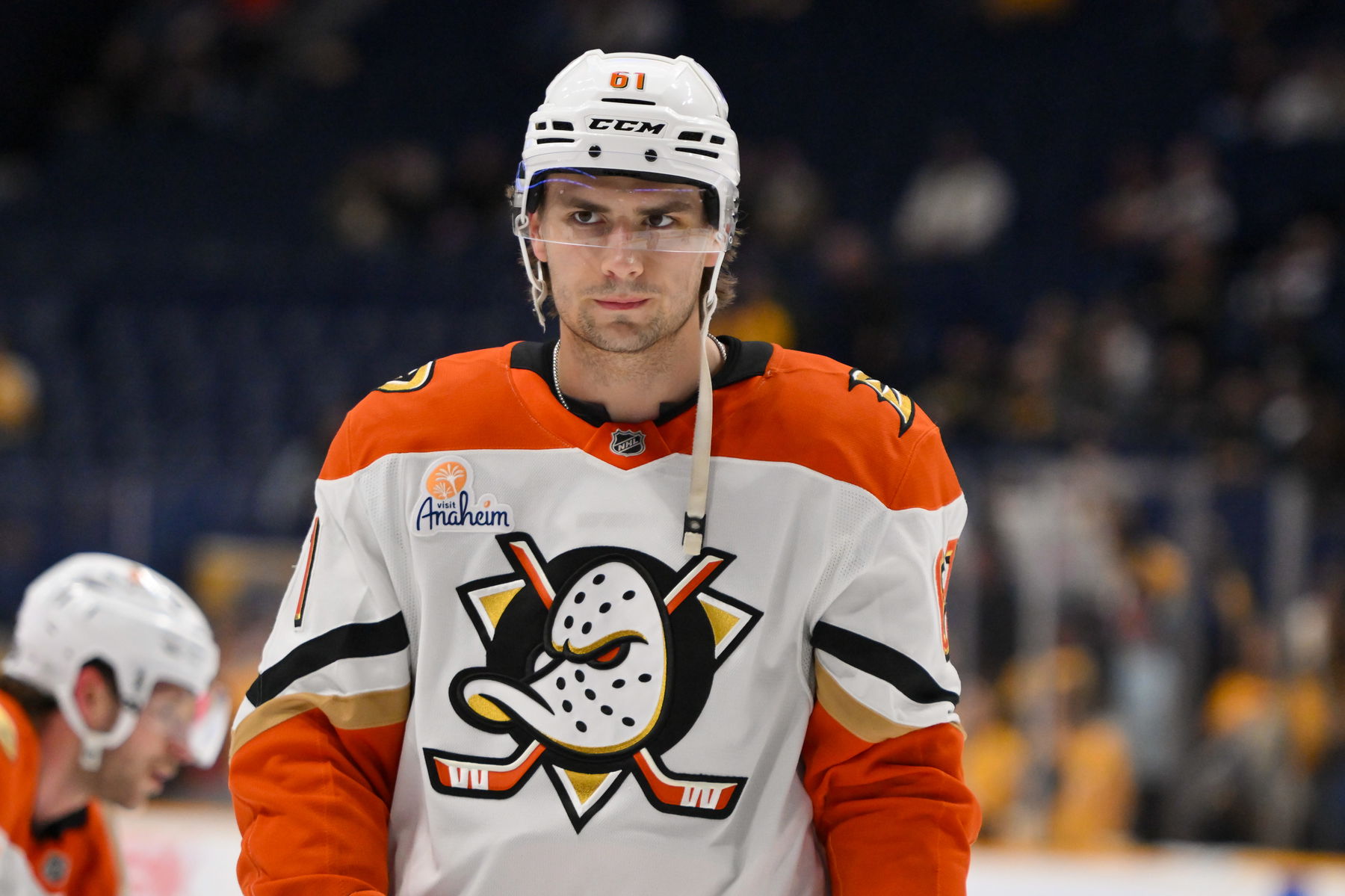 Mar 20, 2025; Nashville, Tennessee, USA; Anaheim Ducks left wing Cutter Gauthier (61) warms up before a game against the Nashville Predators at Bridgestone Arena. Mandatory Credit: Steve Roberts-Imagn Images
Mar 20, 2025; Nashville, Tennessee, USA; Anaheim Ducks left wing Cutter Gauthier (61) warms up before a game against the Nashville Predators at Bridgestone Arena. Mandatory Credit: Steve Roberts-Imagn ImagesCarlsson isn’t the only one whose play has helped drive the team lately. After a slow start to his rookie campaign, Gauthier was yo-yoed throughout the lineup, mostly in a bottom-6 role. Now, Gauthier has been reunited with Carlsson, whom he played alongside in his first NHL game last season. The line of Gauthier, Carlsson and Killorn was a combination that began this season together, but didn’t seem to mesh well in the team’s first few games. They’ve now combined for 16 points in the six games that they’ve been put back together.
“At the start of the season, I think there just wasn't that chemistry that we thought we might have at the beginning,” Killorn said. “But, as we've been going on (throughout) the season, I think all of us have kind of elevated our games from the beginning of the season. Leo is skating great, Cutter’s holding onto the puck a little longer than he was (before). He's more comfortable. It's a big jump from college to the NHL and I think he's playing with a lot more confidence (now). When you combine all those things, our line has every little aspect that makes a good line.”
Killorn is never one to put himself at the forefront, but the impact he’s had on both Gauthier and Carlsson has been substantial. His work with Gauthier during training camp to improve board battles and puck possession along the wall is something that Gauthier has continued to get better at and has been a focus point for Cronin with all of the Ducks’ young players.
Killorn has also been Carlsson’s running mate almost from the moment that Carlsson made his NHL debut, providing a valuable veteran resource. While Killorn may not have the foot speed he once did, he can still turn the burners on every so often and his ability to fill in passing lanes constantly allows him to complement Carlsson with ease.
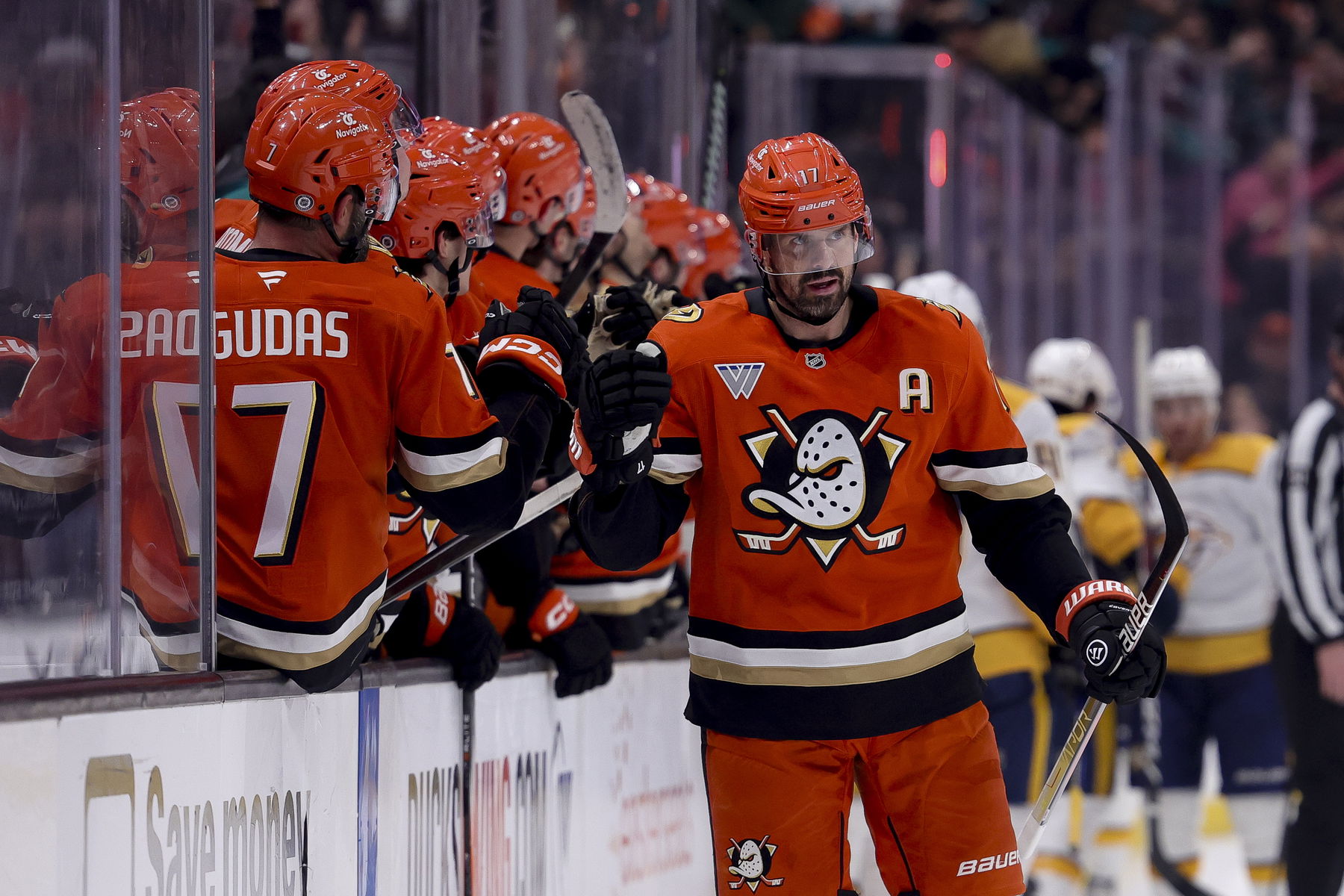 Mar 14, 2025; Anaheim, California, USA; Anaheim Ducks left wing Alex Killorn (17) celebrates with the bench after scoring against the Nashville Predators during the third period at Honda Center. Mandatory Credit: Ryan Sun-Imagn Images
Mar 14, 2025; Anaheim, California, USA; Anaheim Ducks left wing Alex Killorn (17) celebrates with the bench after scoring against the Nashville Predators during the third period at Honda Center. Mandatory Credit: Ryan Sun-Imagn ImagesWith his blazing speed and lethal shot, Gauthier fits like a glove next to Carlsson. He’s fine-tuned his approach after overcoming several obstacles (being benched in the third game of the season and starting the season with an 18-game goal drought) to start the season.
“A little bit of inexperience, not playing in the NHL,” Gauthier said. “I'm just getting my reps, getting used to what the league is like. 60, 70 games later, (I’ve) got a feeling for how this team works, how they function. I’m a lot more comfortable playing with the puck. It's a lot easier now playing with those two than it was at the start of the year.”
“Cutter’s learning how to (protect the puck under pressure better),” Cronin said in January. “He’s a rush guy. He scores goals off the rush. So, for him just to get a confidence level that he can defend the puck with a guy on him, and you'll see it during the game, he might get a little bit stressed out, so he’ll just chuck it to the net or he'll just chuck it into space. That’s a window into how his brain's working. It's a process. It takes time to get people comfortable under that pressure.”
In recent games, Gauthier’s ability to hold onto the puck through pressure and create plays has been on display. Against the Rangers, he curled from the blue line and brought the puck through traffic before ripping a shot that Rangers netminder Igor Shesterkin just barely got a piece of. That play showed a development in Gauthier’s game from the beginning of the season and it was something that teammate Troy Terry noticed and had been preaching to him.
“My messaging to him has always been 'hold onto it,'” Terry said. “'You're strong, fast. Good hands. Don't just defer to the next play, make it hard on the other team.' I think the play (against the Rangers when) he was up at the blue line, held onto it, cut back, skated it back down into the zone and ripped (it), that's what I can see is confidence of a young player––holding onto it instead of just moving it to a different guy and letting them make the play, wanting to make the plays.”
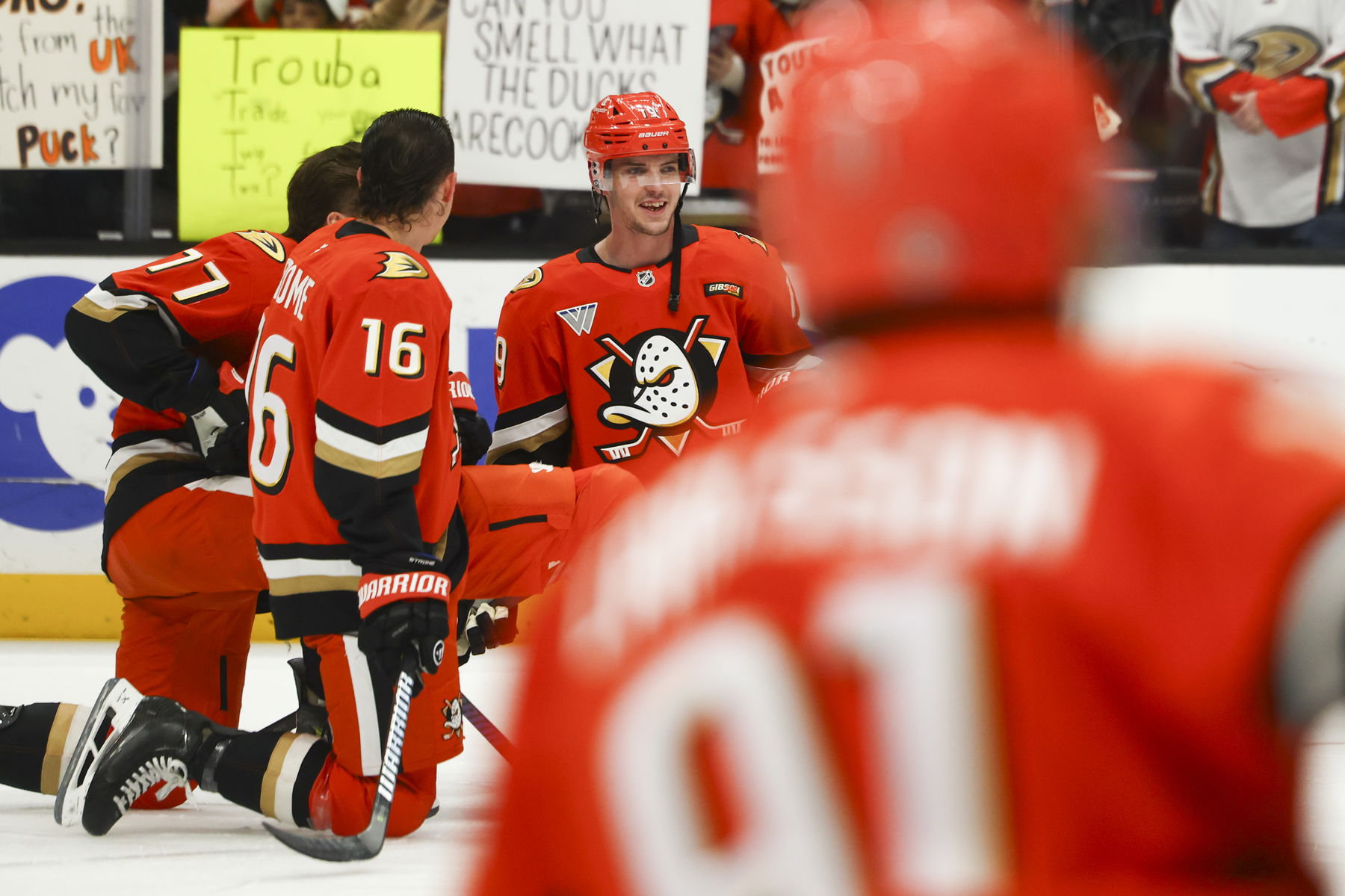 Feb 4, 2025; Anaheim, California, USA; Anaheim Ducks right wing Troy Terry (19) interacts with center Ryan Strome (16), and right wing Frank Vatrano (77) before a hockey game against the Dallas Stars at Honda Center. Mandatory Credit: Jessica Alcheh-Imagn Images
Feb 4, 2025; Anaheim, California, USA; Anaheim Ducks right wing Troy Terry (19) interacts with center Ryan Strome (16), and right wing Frank Vatrano (77) before a hockey game against the Dallas Stars at Honda Center. Mandatory Credit: Jessica Alcheh-Imagn ImagesTerry has a lot of praise for the 20-year-old Carlsson and 21-year-old Gauthier, stating matter of factly, “They’re both way better than I was (at their age),” and mentioning that the duo already has the physical capacity to withstand defenders in the NHL, something Terry did not have when he first got to the NHL.
“They’re both physically strong enough. That was my problem. You can see it, the confidence. You can just tell. Cutter or Leo, if they get a goal (or an assist) early in a game, you can just see their body language (change) and you can see that they want the puck. It’s hard in this league to do that consistently, so I just try to encourage them to have confidence in their skills. They’re good enough to be impact players every night and just trying to be confident with that and want the puck. That’s kind of what I struggled with. I was kind of up and down with my confidence. They are a lot further along than I was, but that's kind of what I'm stressing to them.”
Carlsson and Gauthier’s play of late has represented the confidence that they have with the puck on their stick. Both of them can get into the offensive zone with pace before setting up an offensive chance either for themselves or a teammate. Learning to drive the lanes with purpose instead of just bulldozing through with speed has led to better zone entries and, in turn, more offensive chances created.
“He just uses his speed,” Ducks defenseman Olen Zellweger said of Carlsson. “He has great hands, his head’s up, he's making plays. It’s really easy as a defenseman. You see him going up the ice with the puck, you wanna follow him up because he can cut back and hit you, or he can drive wide and make a play. He's been great, it's really awesome to watch.”
“Cutter's got elite speed, and we knew he could skate,” Cronin said. “Sometimes, it takes a little bit of time for them to get the confidence to drive wide on people. Sometimes, he cuts to the middle, which fractures his speed going down the wall. I think he's trying to sort that out and learn when to drive to the outside. We've made him aware of that. He’s a rush player who can manipulate the defender. He's starting to learn when there is a lane to the outside and then how he can use that speed to put a D on his shoulder (or) on his back. He's certainly a threat when he's got open ice. He's electrifying when he's carrying it and he's in a shooting position, so we're continuously telling him to use that.”
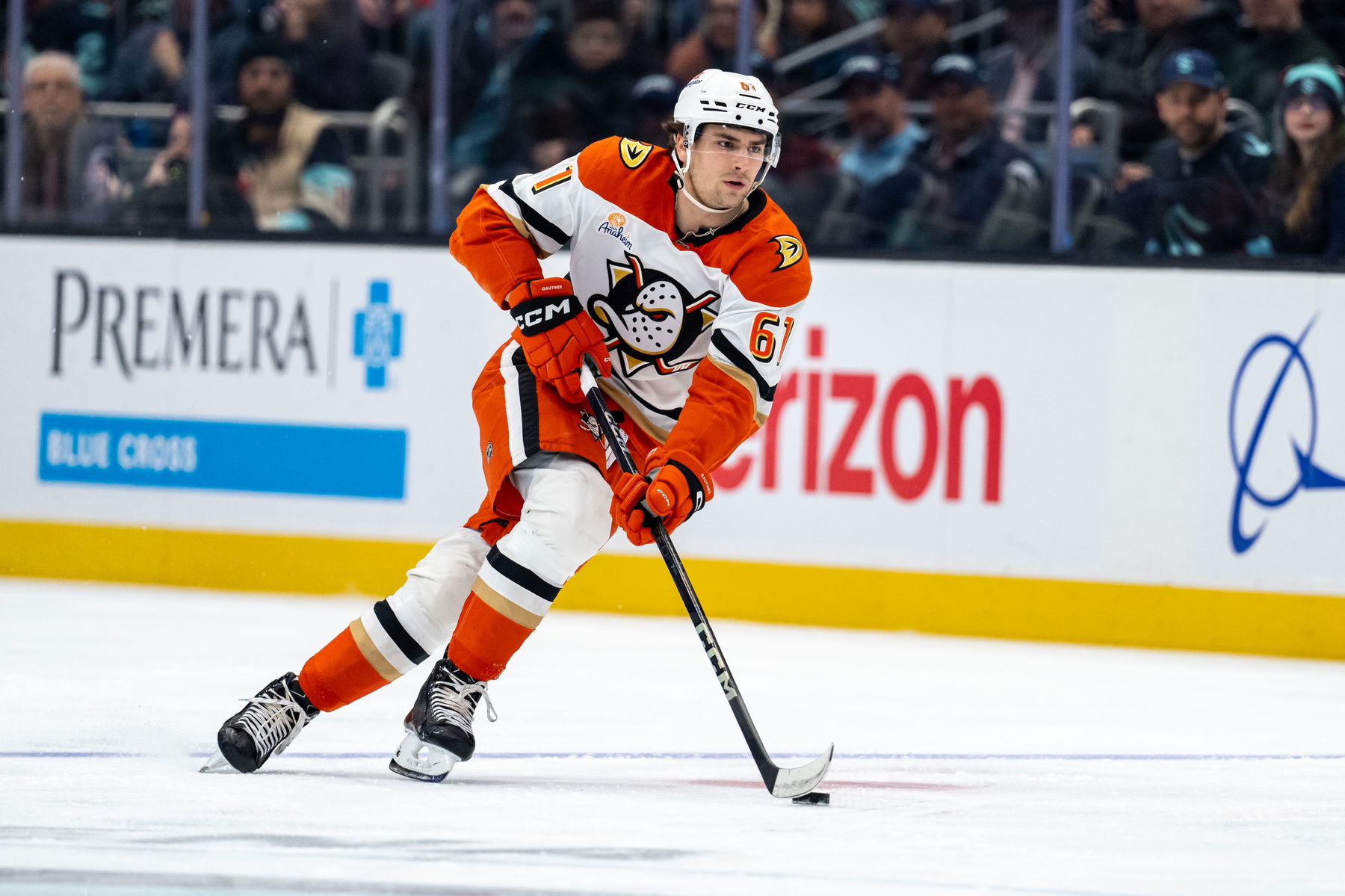 Jan 28, 2025; Seattle, Washington, USA; Anaheim Ducks forward Cutter Gauthier (61) skates with the puck against the Seattle Kraken at Climate Pledge Arena. Mandatory Credit: Stephen Brashear-Imagn Images
Jan 28, 2025; Seattle, Washington, USA; Anaheim Ducks forward Cutter Gauthier (61) skates with the puck against the Seattle Kraken at Climate Pledge Arena. Mandatory Credit: Stephen Brashear-Imagn Images“I think he’s really starting to understand how to use his speed,” Ducks forward Ryan Strome echoed. “When he uses his speed and backs off defenders, he doesn't have to beat them wide every time. He can pull up and create that separation, kind of like a one-on-one in basketball. When they think you're gonna drive the hoop, you can pull back, and you get so much separation. I think he's kind of doing that a lot more now. He’s understanding that he's got that speed and the D are gonna see him and jump back and give him so much space that he can pull up and make plays.”
For Carlsson, his continual rise hasn’t gone unnoticed outside the Anaheim sphere. Rangers forward and fellow Swede Mika Zibanejad got a first-hand look at Carlsson during the 4 Nations Face-Off and while they didn’t play in the same game due to Zibanejad being ill, Zibanejad was one of the players that Carlsson mentioned spending the most time with during that stretch.
“He's an awesome kid,” Zibanejad said. “He's gonna be really good. Unbelievable player. He’s got a lot of attributes that will make him very good for a very long time. He’s so young, and the success he's already had and just the way he plays. I think he's really smart. He's tall, but he's still very shifty in his (own) way.
“I think he’s already proven that he can score. I think (he’s very well-rounded). He can make plays with the IQ that he has. That type of player, you put him in any situation and I think he'll be doing very good, not just fine. Very good in whatever position and situation you put him in. Happy to see a young Swede do well, that's good for Swedish hockey. Again, I'm just happy to see the young guys coming up in the league and seeing the type of players Sweden produces is a testament that we're doing something right back home.”
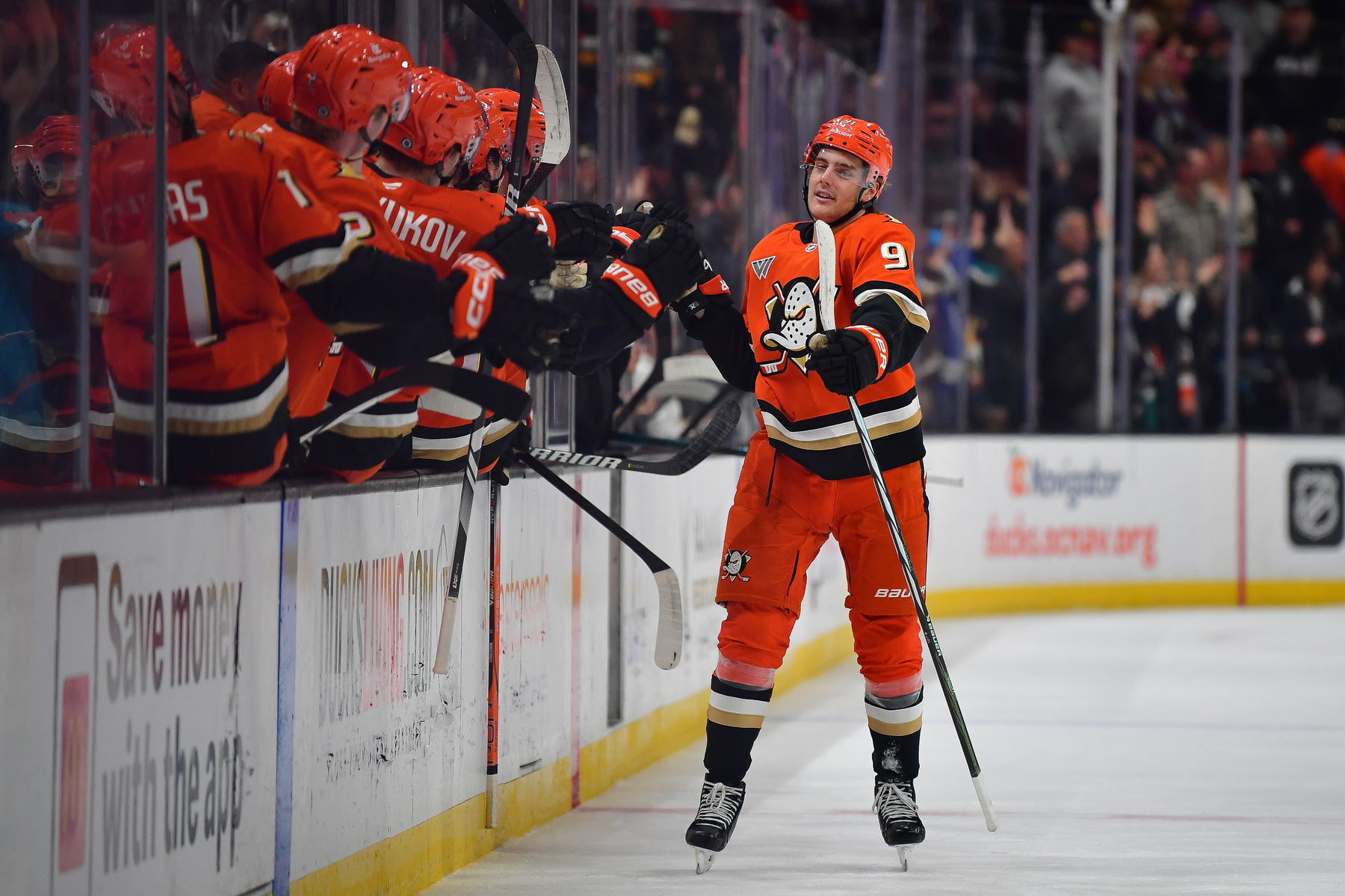 Mar 26, 2025; Anaheim, California, USA; Anaheim Ducks center Leo Carlsson (91) celebrates his shorthanded goal scored against the Boston Bruins during the first period at Honda Center. Mandatory Credit: Gary A. Vasquez-Imagn Images
Mar 26, 2025; Anaheim, California, USA; Anaheim Ducks center Leo Carlsson (91) celebrates his shorthanded goal scored against the Boston Bruins during the first period at Honda Center. Mandatory Credit: Gary A. Vasquez-Imagn ImagesAs their offensive games have developed, so too have their defensive games. Carlsson has been integrated into the penalty killing unit in the final stages of the season, just as he was last season. Cronin has also pointed to Gauthier as someone whose defensive game has improved exponentially since the beginning of the season and could become a penalty killing option as well.
“What I've learned in my relationship with (Gauthier) is that there are certain parts of the game that the NHL guys do naturally well and that you can rely on them as a coach to be really good at it. One of those is defensive zone arrivals. They'll shoulder check, they'll look around, they'll get a sense of what's going on behind them before they make a decision. He wasn't doing any of that (at the beginning of the season), like zero. I was like, ‘What the hell?” (He’d) come down in the D-zone and just stare at the puck, and he's got (opposing) attackers right behind him. I always try to attach performance to certain events in a game that'll make it easier for them. So anybody coming to the D-zone, if they look over their shoulder when they're coming in, they can assess what's coming in behind them. They can make a quality decision. So, that, to me, was a big part of his game.
“I would say hockey is a two-sided coin. There’s an offensive zone arrival, he never looked over his shoulder to get a puck in the offensive zone either. If you noticed earlier in the year, he was just taking pucks and chucking them to the net. At one point, he had like the most shots on net for a rookie and he still might have it. To me, they weren't purposeful shots. They were reactionary shots that were tied to his natural DNA, which was ‘I’m a shooter, I'm a shooter, I’m a shooter’. Well, you’re turning the puck over in the NHL because if you’re not hitting the net. It's going out the other side and they're coming out on a breakout. So, just that awareness of what's going on around him, both defensively and offensively, was very absent. And I think as he's started to look, he started to slow the game down defensively and offensively, ironically, has come later for him. He’s starting to do it now offensively.”
This Ducks team is sprinkled with several top-10 picks, most of whom were drafted by the organization. Carlsson and Gauthier lead the way as the two most recent top-10 picks from that crop. As they continue to progress through the “building” stage of their rebuild, being able to have those two as their “top dawgs” will go a long way.




